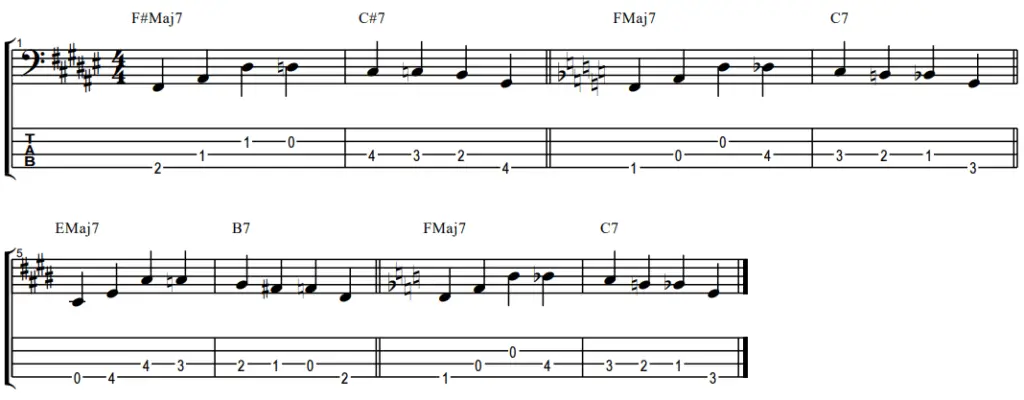After 16 years of playing the bass, I`ve realized that playing a walking bass line is simple, but playing a walking bass line well is hard.
In their simplest form, walking patterns consist of a simple rhythm and basic melodic pattern. However, there is a lot more that goes into playing a walking bass groove that fits a song perfectly and adds something unique to it.
That`s why I`ve made these easy walking bass exercises. They will teach you the essential techniques required to play great walking bass lines, in a beginner-friendly way.
The guide will make you familiar with common melodic patterns and rhythms that jazz bassists use. You will also learn in what contexts these techniques can be applied, and how to use them to improve your own playing.
1. Chromatic movement
Let`s start off with a simple quarter-note walking bass line.
This is the most common walking rhythm you will run into. So much so that when asked what a walking bass line is, many people will think of this exact rhythm.
In terms of melody, this exercise uses a 1-3-4-4# pattern. This means it consists of the root note, third and fourth of the scale, followed by a tritone (4#). The 3rd and 4th bar uses a 1-3-5-4# pattern which also includes the fifth note of the scale.

The reason I`ve used these two melodies for the first exercise is that they are both common bass patterns.
These melodies are great for giving your lines a “walking” sound. This is in large part thanks to their chromatic movement and their use of the tritone.
To play chromatically means to play half-steps, such as C-C#-D in the above example.
The Tritone is the 4# or 5b of the scale. This note is rarely a part of the scale in most cases and thus sounds unresolved. This creates a feeling of the bass line intending to walk up to the 5th, or down to the 4th.
Thus, these patterns work great for attaining a typical walking sound, and you will find them in many of the best walking bass lines of all time. These patterns also work over many common chord progressions, and there are countless situations where it can be used.
Once you get comfortable with the exercise, you can also practice this pattern in other keys. Furthermore, you can opt to change the key as you play the exercise.
For example, you might try playing it in A major, and switch to its parallel key, F# minor. This will further develop your control of the pattern as well as your knowledge of the fingerboard in general.

2. Basic walking patterns
Another two common walking bass line patterns are 1-3-6-5 and 1-3-6-6b.
Similar to exercise 1, both these patterns lead to different notes. The 1-3-6-5 pattern leads into the 4th, just like the 1-3-5-4# pattern above. The 1-3-6-6b pattern leads to the 5th, just like the 1-3-4-4# pattern above.

Notably, both patterns in exercises 1 and 2 can both be played in minor and major keys. This makes all 4 patterns versatile and applicable in many situations.
This is because it is common for jazz chord progressions to lead into IV and V chords at some point. As the 4th is the root note of the IV chord and the 5th of the V chord, these patterns can thus be used in tons of songs.
Once you get comfortable, you can practice the pattern further by moving it to an adjacent mode as you play it. This has the added benefit of priming you for playing modal jazz in addition to making the pattern second nature.

3. Fifths and octaves
This exercise consists of “safe” notes that will work in almost any chord progression.
More specifically, the pattern is made out of a root note followed by the fifth and the octave. This exercise thus uses a 1-5-8-5 pattern.

Harmonically, this type of groove is about as simple as a walking line can be. However, it also constantly makes giant melodic leaps. This groove thus provides a sense of movement to a song and can do a lot to propel it forward.
The pattern can serve as a great tool when you feel lost when improvising over a chord progression. This is because the fifth and octave are among the easier notes to locate as long as you know the root note.
Related reading: 5 Essenetial Jazz bass scales
The octave is always included in the chord as it is the same note as the root note. The fifth is also included in the vast majority of chords. As a result, this line will work in almost any context. Thus, in addition to sounding great on its own, it can also serve as a way to find your way back into the groove.
4. Changing octaves
The following exercise will help you make your walking bass lines more interesting and dynamic.
What`s great about it, is that you can use it in any circumstance and still sound harmonious with the rest of the band. The way to do this is to simply move the first note of your line up or down an octave. To keep things simple, let`s try doing this with exercise 2:

As you might notice, the notes are exactly the same, but the whole feel of the walking bass line changes.
Thus, you can use this simple trick when you feel that your bass lines are getting stale or too repetitive. You can also practice this by trying it with any of the other exercises in this article. You can also try it with any song you already know how to play.
This method often works best when you change the first note of the bar. This is because this is the note where adding more emphasis generally feels the most natural.
However, once you become comfortable with the technique, you can experiment with shifting other notes of a line up or down an octave. Finding the right spots to do so can be tricky, but it is definitely worth experimenting with when you get the hang of changing the first note of the bar.
5. Triplet 8th note feel
The last 4 exercises have been centered around the melody. This one is centered around playing walking bass lines at a different rhythm.
More specifically, it teaches you how to play with a triplet feel. This is a common way to play walking that breaks with the common quarter note rhythm. The exercise below is a version of exercise #1 and shows how different the same melody can sound when played with a triplet feel.

It`s called a triplet feel, as triplets are sets of three notes that are played where there would normally only be time for two. This can mean playing three fast quarter notes instead of two slower ones. It can also mean playing three 8th notes where only two could normally fit.
Straight 8th notes at a triplet feel are subdivided into a quarter note and an eighth note. As they need to be played in the timeframe it would normally take to play 2 eight notes this makes the notes faster.
The result is a groovy way to play the bass, and one that you have no doubt heard in many jazz songs in the past.
Making your playing sound tight in this rhythm can be hard at first. One way to get a better feel for it to start with is to use a metronome with a triplet feel setting. Some physical metronomes have a setting for this. Alternatively, you can use this free triplet-feel metronome from MusicAllTheTime for the exercise.
6. Drops & Repated notes
There are various bass techniques that are called drops. One of them is done by moving down a minor third interval from the root note. Then, walk up to the fifth note on the next bar.
This is a technique jazz bass players use to make their grooves sound more dramatic and dynamic. Thus, while simple at its core, this common bass technique can do a lot to elevate your lines.

The low note that we drop down to is often played on an open string when using this technique. It is not a requirement to play drops, but the resonance of the open string gives that low note an extra bit of punch.
Thus, similar to changing octaves, the drop is a great technique to pull out if you feel that your line is starting to sound stale. It can also be great for accentuating a new part of a song or simply adding some variation.
A notable example of this is one of the best jazz bass lines of all time, Duke Ellington`s Take The “A” Train, which ends with a drop.
Furthermore, the above exercise also introduces repeated notes.
While walking in lines need to walk somewhere, playing repeated notes can often help in adding suspense and variation to them. Thus, repeated notes can paradoxically help guide a walking groove.
They are also a harmonically safe option, especially when sticking to chord notes such as the root, 3rd and 5th.
7. Rhythm changes
Lastly, let`s look at an example of how the rhythm of a walking line can be changed.
A big part of playing walking bass is to lock in with the drums and stick to a groove. While it`s important to be able to do so, it is also important to be prepared for when it’s time for a change.
This is thus a helpful exercise for learning how to break with the walking rhythm, as well as getting back into it. As this is the last exercise, it also combines many of the techniques you have learned above:

Paul Chamber`s bass lick on Miles Davis` So What is a prime example of how to do this well.
In the song, he plays a walking triplet feel the groove, which he breaks up with rests and long sustained notes. Thus, he is able to retain the walking feel of the song, while working together with the rest of the band to create a cohesive motif.
Experimenting with rhythms affords you limitless possibilities in how to play walking lines. However, you also need to be careful with how you do it, as changing the feel of a groove too much can interfere with the feel of a song.
Oftentimes, sticking to a basic quarter note or triplet feel is often what will serve a song the best. However, getting creative with rhythms is amazing in some contexts, and is a great way to take your bass playing to the next level.

